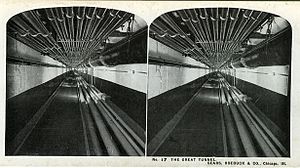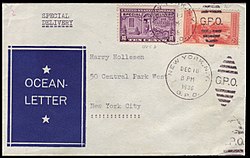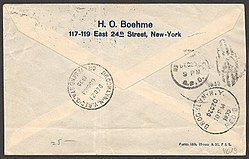Pneumatic tube networks in America

Outside of Europe, the largest pneumatic tube system that could also transport parcels existed in New York City. There were also corresponding plants in Boston, Chicago, Philadelphia and Saint-Louis. There were also pneumatic tube systems in Buenos Aires (Argentina) as the expreso urbano (city express service ) of the telegraph office as well as in Rio de Janeiro and São Paulo (both Brazil). In Brazil, as in Argentina, the pneumatic postal stationery was published by the telegraph administration, which indicates the original purpose of the pneumatic tube network to speed up the transmission of telegrams in large cities. There was also a pneumatic tube system in Algiers (Algeria), which was still in operation until shortly after the end of French colonial rule (operating period from April 4, 1910 to July 5, 1962) and, as far as it has become known, partly as exprès urbain (city express traffic ) was also supplied with other transport options.
United States of America
Boston, Massachusetts
The Boston Postal Pneumatic Tube System was put into operation on August 6, 1926, and therefore quite late. No information is available about the extent of the pneumatic tube network in Boston and its subsequent history.
Chicago (Illinois)
Little is known about the Chicago pneumatic tube system. The stamp on the item shown shows that the item is being forwarded by post and that the Post has fed this postcard into Chicago's pneumatic dispatch . As everywhere in the world, the pneumatic tube system was u. a. used to feed mail to be forwarded into the correct connections as quickly as possible.
The pneumatic mail of the mail order company Sears, Roebuck & Co (1905)

The oldest and, for a long time, largest mail-order company in the world, the company Sears, Roebuck & Co. , had an in-house pneumatic tube at its headquarters in Chicago in 1905, which sent up to 70,000 pneumatic tube boxes with orders, company-internal information, packing slips, etc. every day . An average of 7,000 orders received by post were processed every day. This corresponds to around 2.5 million shipments processed annually, which corresponded to or even exceeded the volume of pneumatic post in large cities at that time. The pneumatic tube network extended over the entire 40 hectare area of the company headquarters with administration building, warehouses and shipping departments and had a length of 15 miles (approx. 24 km). It is thus comparable to the postal and telegraphic pneumatic tube networks in Berlin, Paris and Marseille at the time of their commissioning.
New York (New York City)
As in Berlin, a telegraph company in New York was in charge of the development of the pneumatic tube. The New York pneumatic dispatch network was installed in the late 19th century by the Western Union Telegraph Company and connected the neighboring post offices and the railroad terminals in the form of pneumatic dispatches distributed throughout the city. H. the railway post offices. In 1868, connections to the neighboring cities of Brooklyn, Staten Island and Jersey City were also planned, of which at least the connection to Brooklyn via the Brooklyn Bridge was put into operation. The New York City Council was responsible for the operation of the system and had to pay the owner a rent as well as the staff for the operation. The city's orthogonal course of the street (especially in Manhattan) met the economically favorable expansion of the New York pneumatic tube network. In addition, crossing under the waters around New York represented an inexpensive alternative to technically more complex installations such as bridges. In the course of its greatest expansion, the network reached a length of 27 miles (approx. 44 km).
The pneumatic tube containers in New York could each transport up to 600 letters - in addition to transporting telegrams and express mail, the network was also used to transport mail to be distributed between the distribution offices and the individual delivery offices. The pneumatic tube was able to transport mail from one office to another about five times faster than the mail car on the road. As a result, the distribution of the mail for a delivery was usually already done at a point in time at which the mail car would not have reached its destination. The pneumatic tube network in New York was in operation until the 1950s. During a reconstruction of the Brooklyn Bridge in April 1950, the service between New York and Brooklyn was interrupted and then never resumed. This suggests that the need was probably no longer very great. In the rest of New York City, the pneumatic tube service was interrupted in 1953 for the purpose of revision and was not resumed thereafter.
Shipments that have been transported by pneumatic tube from New York can have one or more postmarks on the back. This is primarily the case for shipments that have been posted by express couriers ( special delivery ). Ordinary mailings usually do not have this stamp. The following procedure can be deduced from the postal history material obtained: Items that were transported by pneumatic tube mostly received an arrival stamp from the corresponding pneumatic tube station on the back. This stamp shows REC.D for received . In contrast to the usual stamps of the US American Post, which have an hour setting with the additional note AM ( ante meridiem = morning) or PM ( post meridiem = afternoon), the stamps of the pneumatic tube exchange or receiving stations show a 30-minute setting . This means that it is possible to reconstruct to within half an hour the route by which a pneumatic tube, express courier or telegraphic shipment was transported. This time setting obviously corresponds to the timetable of the pneumatic tube trains, which because of the large capacity of the New York pneumatic tube capsules did not have to travel as close together as those in Berlin or Paris.
South America
Buenos Aires (Argentina)

Very little is known in Europe about the pneumatic post from Buenos Aires and the documentation situation is also very poor in Argentina. What is known, however, is the expansion of the Buenos Aires pneumatic tube network, as an overview map of the Buenos Aires network is shown on the pneumatic tube postal stationery of the Argentine Post. Some details of the procedure are also known, as it is described in detail on the card letters. In this way, pneumatic post card letters could be posted at the connected telegraph offices. They were then transported on to the recipient with the expreso urbano . Likewise, these shipments could be handed over to the messenger of the expreso urbano on the open road against receipt for delivery . If the prepaid reply option was used, the recipient had the option of entering an answer of no more than 20 words, including the address, in a form specially provided by the messenger. This answer, because it was prepaid, was then sent at no additional cost. However, if the respondent needed more than 20 words, the reply was sent by normal mail. Posting via the mailbox was also possible. However, it was advised to pay attention to the emptying times of the mailboxes.
In the illustrated route map of the expreso urbano, it is not clear which routes were served by pneumatic tube and which by a city express service. What is certain, however, is that since 1928 the Hamburg company Carl August Schmidt & Söhne had been commissioned to expand the urban pneumatic tube in Buenos Aires. So it says in the commemorative publication published for the 100th anniversary of this company in 1941:
"The contract we concluded with the Argentine government in 1928/29 for the post and telegraph management in Buenos Aires on the basis of an international tender for the delivery of a city tube post system for Buenos Aires put us in dire straits. The system included the connection from 14 post and telegraph offices in the city with a total length of 72,000 meters with 42 machine sets. As a result of revolutions and repeated changes of government in Argentina, the agreed installments were not paid, although the system was already up to 65% operational. The construction time, which was scheduled to be 1½ years was, lasted 8 years. Large interest and exchange rate losses were the inevitable result. When the first installments finally came in, the system was completed by us and the remaining installments were paid by the Argentine post and telegraph administration, but in a strongly devalued currency final completion The system was accepted by the Argentine authorities without any complaints, as the absolutely trouble-free operation had been proven for a long time. "
It is not clear from this information which routes were expanded by the Hamburg company in Buenos Aires. In any event, the substantial 72 km extension of just 14 post and telegraph offices has been added to the pneumatic tube network.
Individual evidence
- ↑ 100 years of C. Aug. Schmidt & Sons , Hamburg 1941, 28.
literature
Pneumatic tube New York
- Beach, Alfred Ely: The pneumatic dispatch, with illustrations: a compilation of notices and information concerning the pneumatic system of transportation as new building and operating in England; together with accounts of its first trial in the United States, and of proposed applications of the system to passenger and postal service. .. , New York 1868
Web links
Pneumatic tube New York
- Pneumatic mail in the USA, especially in New York in English with illustrations
- Beachs pneumatic dispatch Detailed description of the development of the New York pneumatic system in the 19th century in English with illustrations
- Beach's pneumatic tube system for moving people in New York in English with illustrations
- F. Rothe: "Cross-section through the postal conveyor technology of the United States of America with special consideration of the 8-inch city tube post systems ", in: Archive for Post and Telegraphy , 67th year, No. 10, Oct. 1939, p. 289 -309.








